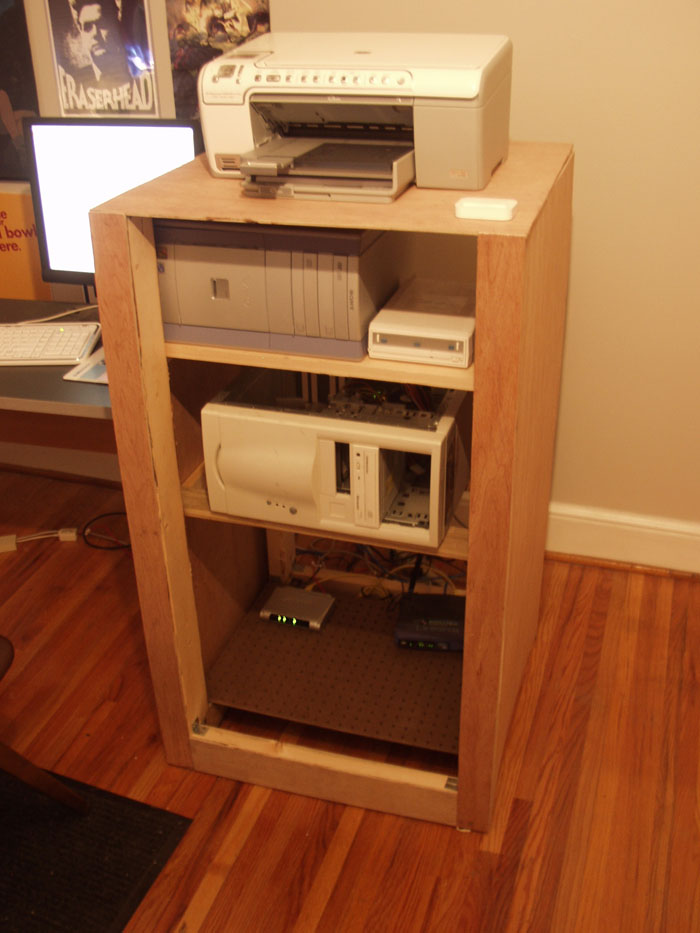|
Forums : http://www.forums.woodnet.net http://www.sawmillcreek.org/index.php http://lumberjocks.com/forums Video Podcast Sites, Blogs and Instructional Classes and other Resources: http://www.woodworkingonline.com/ Videos http://thewoodwhisperer.com/ https://woodworkingmasterclasses.com/ https://paulsellers.com/ http://www.renaissancewoodworker.com/ https://videos.popularwoodworking.com/ http://blog.lostartpress.com/ http://www.popularwoodworking.com/woodworking-blogs/chris-schwarz-blog Audio Podcasts:  An audio podcast produced by Marc Spagnuolo (The Wood Whisperer) and two of his buddies Shannon Rogers and Matt Vanderlist. http://www.thewoodwhisperer.com/woodtalk/  From the staff of Fine Woodworking magazine. Woodworking Supplies: https://www.rockler.com https://www.woodcraft.com https://www.amazon.com https://www.woodpeck.com https://www.leevalley.com https://www.lie-nielsen.com Here are some book recommendations: Taunton's Complete Illustrated Guide to Woodworking Bad Munki weighs in on this series of books by Taunton Press below: There are a hell of a lot of books in this series. Joinery - Tied with Flexner's wood finishing for #1 most useful woodworking book. Excellent illustrations and photos. Shows detailed how-to instructions for every joint you'll ever need and when you would need to use it. What really makes it shine is that it gives instructions on how to make the joints with different tools. Instead of saying "to make X joint, use Z tool and ...." it is more like "to make X joint using a table saw, do it like this. For a router, do it like this. For a bandsaw and a jointer, do it like this." Shaping Wood and Period Furniture Details. Buy one or the other. There is a lot of duplication between these two books. Not just similar ideas, but identical chapters. Taunton is (to me) the best publisher of woodworking books, so it was kind of a letdown to see two high-priced books in the same series to have so much duplicate material. Furniture and Cabinet Construction and Box Making. Both very good books for specific types of woodworking. As par with the rest of the series, the illustrations and photographs are excellent. ************************************************** Understanding Wood Finishing by Bob Flexner Bad Munki says : Tied for #1 most useful woodworking book I've ever read. Everybody just assumes "Stain and poly" is just the way you finish a woodworking project because that is the only option. In my very biased opinion, smearing stain ("RBS" or "Reddish Brown poo poo" as one usenet rec.woodworking member called it) is a quick way to make your carefully planned and constructed woodworking project look like poo poo. There are much better ways of finishing your project that will bring out the beauty of the wood and Flexner goes into great detail on the How and Why. Tage Frid Teaches Woodworking 3 Book Set Classic Joints With Power Tools by Yeung Chan The Complete Woodworker's Companion by Roger Holmes Illustrated Cabinetmaking: How to design and construct furniture that works by Bill Hylton Traditional Finishing Techniques Understanding Wood by R.Bruce Hoadley Bad Munki: "This isn't a book you are going to sit on the toilet and read to pass the time while thinking of your next woodworking project. Think of it as "The Machinery's Handbook" of woodworking. It covers every technical aspect of wood that you can imagine. If you are planning on building a credenza out of pine and cocobolo, this book will tell you exactly what to expect for expansion and contraction movements based on humidity levels. It is a reference manual, and the best there is. Methods of Work: Workshop: The Best Tips from 25 years of Fine Woodworking Bad Munki: "There are a few books in this series covering general woodworking ideas, router ideas, tablesaw ideas, bandsaw ideas, etc... All of the books are excellent. As the title says, they are a collection of reader tips from Fine Woodworking magazine. As I turn through the pages of the books and read the tips, I keep saying to myself, "drat, that's brilliant! I never would have thought of that." The Workbench Book by Scott Landis Bad Munki: "My personal favorite woodworking book: . This is a book that you will sit on the toilet and read until you have a dark red ring around your rear end from the toilet seat and realize the rest of your family has gone to bed without you. Each chapter covers a different type of workbench, but it looks at it from the perspective of "What type of woodworking is going on in this time period" and then goes on to describe how they designed workbenches to suit their needs. It will really make you think about what you need based on the type of work you are doing and gives a lot of information on vices (tail vice, end vice, leg vice, etc...) and what they are useful for. It also goes into a lot of the details of construction of benches, but doesn't have measured drawings or plans." IK Edits: Old Hand Plane (Stanley) info: Leperflesh posted:Supertool is one of the three insane hand plane sites I refer back to regularly. Here are the other two: Somebody fucked around with this message at 00:14 on Nov 5, 2021 |
|
|
|

|
| # ? Apr 25, 2024 00:24 |
|
How much about woodworking did you really know when you first started? I'm a total newbie who has just recently purchased an the basics of a shop but I know absolutely nothing about it aside from what I've read and watched on DIY. I couldn't actually MAKE something to save my life, and I'm a little disheartened. The chair looks great; how long did it take you to make?
|
|
|
|
I knew absolutely nothing. They way I fell into it was midway into last year I saw the "Build your own speakers guide" in the Audio/Video forum here. I decided it was something I'd like to try, but I had no tools. A trip to Lowes and 900 bucks later I had a Porter Cable plunge/fixed based router, Random Orbital Sander, Dewalt circular saw, Dewalt drill and assorted screws and glues. When I finished that I was really impressed with how it turned out, and I had something USEFUL to show for it. From there it just snowballed insanely fast. You can learn with nothing more than the internet and books, thats what I did. I get frustrated all the time, something looks really simple to do and I gently caress it up, or I can't get a tool to work precisely right. Its worth the frustration, though. I'm hoping to find someone local who really has some experience to learn from. The chair probably took 11-12 hours going from rough lumber given to me for free to a chair. The plans called for 3/4 inch wood, so I had to plane it down from 5/4. 5/4 means 5 quarters of an inch, or an inch and quarter. Jointed and straightened everything using my jointer/planer/tablesaw. Used a square to trace gridlines for laying out the curves on the pieces, cut the curves on a bandsaw, the straight lines on a tablesaw and smoothed everything out with a belt/disk sander. I'm still applying spar varnish as we speak. With templates and perfectly square and smooth lumber already at 3/4" the time would probably be a 4-5 hours, maybe. But it would cost an absurd amount, if you've ever noticed how much Lowes and lumberyards charge for S4S lumber. S4S = Surfaced on 4 sides. Edit: Here are the cutting boards and a box I made to hold pocket screws while trying out my Leigh Dovetail Jig. The screw box is walnut and purpleheart. The tri colored cutting board is Walnut, Jatoba and Curly Maple. The bicolored board is Padauk and Walnut.   
ChaoticSeven fucked around with this message at 22:05 on Apr 8, 2008 |
|
|
|
Those look great! I'm going to start on my first real project here next week, I'll post it here when it's done.
|
|
|
|
Ah, a timely thread. The "build a canoe" thread has inspired me to try my hand at woodworking in general. Being that I don't think I've done anything remotely like it since my 7th grade shop class, I signed-up for a class at the local community college. Only $15, not a bad deal. Anyway, looks like a lot of great info here. Hopefully I can actually manage to turn some stuff out eventually..
|
|
|
|
I've been doing a lot of jewelry boxes with the shop on my University's campus, hopefully I'll be able to get some pics up tonight. Hopefully I'll be getting my Lie Nielsen block plane and card scraper soon
|
|
|
|
Those cutting boards look great! I've actually been wanting to try my hand at some basic woodworking by creating my own nicely polished Scrabble board (was thinking about 1" thick). Wasn't sure how expensive a project this might be to undertake because I don't have any of my own tools yet, so I'd appreciate any suggestions as to what tools I might need and what wood would be best to build it out of. *edit* Also, I live in an apartment so I'm not sure how much more difficult that would make things for a project like this.
|
|
|
|
hamsterhuey85 posted:Those cutting boards look great! You have to give us entirely more details on how you want this board to look/function. Are you looking to build a case around a standard scrabble board? Or are you looking to make a wooden playing surface? Do you want the dividers that hold the pieces on more modern boards? Seeing as you're relatively new to this I'd recommend you look over the wood whisperers video on cutting boards. Keep in mind that he uses end grain facing up for his boards and that is entirely unnecessary for your purposes. As far as tools you would need, a circular saw, and some clamps are really all you need for that. Make sure to get clamps wide enough to clamp the board together. EDIT: a drawing would really help us determine what you need and what is doable (even a rough mspaint drawing) Cmdr. Chompernuts fucked around with this message at 17:35 on Apr 10, 2008 |
|
|
|
I really want to turn mugs or bowls on my school's lathe. Any guides to elementary lathe education? I've had the intro lathe course so I know my way around tools and speeds, but I've only done lathework where the piece was locked on from one side and had the spike on the other. I just like the look of black wood kitchenware.
|
|
|
|
Not an Anthem posted:I really want to turn mugs or bowls on my school's lathe. Any guides to elementary lathe education? I've had the intro lathe course so I know my way around tools and speeds, but I've only done lathework where the piece was locked on from one side and had the spike on the other. I just like the look of black wood kitchenware. This should shed a little light on the basics of hollow forms. I haven't invested in a lathe yet, I've heard its a black hole for money. People with very nicely outfitted shops say the lathe and its accoutrement's cost the most cash. http://www.newwoodworker.com/turning/bwlbsics.html
|
|
|
|
So, have been attempting to learn some basics and terminology and what not so I don't appear to be a total fool when I start my woodworking class. I've watched a lot of the Wood Whisperer videos and poked around at some of the websites from the OP. I'm now wondering if there are any books or magazines I should check out? Or would I not really understand those until I get some actual experience? Also, can somebody please explain to me what a jig is? I see people talking about jigs everywhere, and I think I have an idea, but I imagine the idea I have is wrong. And do you have a place to get plans or a how-to guide for those cutting boards? Because they are pretty awesome.
|
|
|
|
I'm in the same boat, I've been reading a lot. I believe a jig is just a template to cut something else, whether it's dovetail joints, etc.
|
|
|
|
PMan_ posted:So, have been attempting to learn some basics and terminology and what not so I don't appear to be a total fool when I start my woodworking class. I've watched a lot of the Wood Whisperer videos and poked around at some of the websites from the OP. I'm now wondering if there are any books or magazines I should check out? Or would I not really understand those until I get some actual experience? Taunton's Complete Illustrated Guide to Woodworking does a nice job of illustrating (dur) all the basics. You can pick it up at Amazon for around 20 bucks. Magazines? I don't have a subscription to any but I've heard good things about Shopnotes and Woodcraft. Shopnotes seems to be orientated toward jigs and shop furniture more than anything else. Jigs. I think of jigs as anything constructed or bought by you to make it easier or, in some cases, even possible to do things with tools. A simple example would be cutting a perfectly straight line with a router. Try doing that freehand and come back to me. Now clamp a straighedge to the surface of whatever you wanted to route and let that be your guide as you push the router along. Bam, easy. A jig. There are dovetail jigs for routers, crosscut sleds for table saws which make it easier to crosscut wide boards or glued up panels, 45 degree miter sleds, jigs to mark perfectly spaced holes for shelving pins, featherboards to hold a board against a fence as you cut it. Lots of things are jigs, whether you think of them that way or not. Those cutting boards are really dead simple. Get 2 or 3 different types of suitable hardwood that is flat and square. Cut the strips to the size you want the various stripes of color to be, slap some waterproof or water resistant glue on the edges and clamp em' up. Tightbond II will work, people used it for years. Tightbond III actually says waterproof on the bottle though, so I use it unless I'm out. After the glue dries you simply trim the edges off perfectly square, cut a finger hole in whatever shape you desire with a router or a forstner bit in a drill press and roundover the edges. You can use a roundover bit on a router table for that part if you want it really round, or simply break over the edges a bit with hand sanding. Ok, sand the cutting board perfectly flat on both sides, wipe off the dust and apply a metric poo poo ton of "mineral oil". Yep, the stuff you see at the drugstore all the time. Its cheaper to buy it there than at Lowes or something. You can fill a pan with it and drop the whole thing in there, or apply it by wiping on a bunch of coats until it no longer absorbs into the wood. Some people also like to heat the oil on the stove and melt wax into it, and put the board in that mixture. Thats probably the best way to go, but I have yet to do it myself. You can also do "edge grain" cutting boards, which is end grain up instead of the face grain. It wears better, both on the knives and the board because edge grain resembles a million little straws. When you draw a knife across it, the straws simply part out of the way instead of being cut in half like they are on face grain cutting boards. Keeps the knife sharper, longer, and the board looking nicer for a longer time also. Of course, all you have to do to restore a cutting board to its former glory is sand it. Poof, brand new. The downside to edge grain boards is it's a real bitch to get those things sanded down smooth. Any other questions just ask, I'm glad to share what little I've picked up in the last few months, totally new to this myself. Right now I'm working on a dovetailed cedar chest, but work has really picked up the last few days and I'm not sure when I'll be able to finish it. I'll try to get pictures of the work in progress up soon.
|
|
|
|
Fantastic, the wife works at a library so I had her snag that book for me. It does appear to be a really great resource. Granted I've only read the table of contents so far, but hey. The cutting board does sound relatively easy. I'm sure I'll find that it's actually fairly complex, but we shall see. Thanks for the info!!
|
|
|
|
PMan_ posted:I'm now wondering if there are any books or magazines I should check out? In woodworking there are two basic camps... the neanders (as in neandertool) who use primarily handtools and those who use primarily power tools (sometimes called Normites as in Norm Abrahm). Of course there are many people like myself who in the middle. The neanders all swear by Fine Woodworking which is a fantastic magazine but you'll only need one years worth as they recycle articles worse than any magazine I've ever read and every project will either be Shaker or Mission style and use the same joinery techniques. I would say buy their books and forget the magazine. Personally I like Wood. They of course do some article recycling but they do a couple of interesting things... their projects use a variety of joinery, often unnecessarily complicated but interesting nonetheless; frequently their articles are part of a series so that each issue shows you how to make one piece in a suite of furniture in a certain style; and they include patterns for many projects. The British woodworking magazines stomp the American magazines but they can be difficult to find and expensive. Books I Own: my personal favorite: The Complete Woodworker's Companion by Roger Holmes I don't see this book mentioned often, its not from Taunton which is probably why but it shows you all the basics of woodworking through a series of projects that are accompanied by some of the best illustrations and photos of any woodworking book I've read. Illustrated Cabinetmaking: How to design and construct furniture that works by Bill Hylton Basically a textbook on furnituremaking. (in woodworking, furniture makers are called cabinetmakers) Understanding Wood Finishing by Bob Flexner For years it was the final word on finishing. There is another book out with a similar title and some differences in technique maybe but I've yet to go wrong with Flexner's book. He also dispels many myths about finishing. Traditional Finishing Techniques, a collection of articles from Fine Woodworking I don't even remember buying this book, maybe it was a gift, but it contains articles fleshing out the finishing process and a few things Flexner doesn't touch on. Some authors to look for: Tage Frid Franklin H. Gottshall (if you become interested in furniture)
|
|
|
|
I've not done any woodworking since I was in high school, but I finally have a place with an area in the basement I could turn into a workshop and have been thinking of getting into it. I'd like to make a coffee table or two first off, since we need at least one and haven't been able to find any that we liked. How hard a project would this be, and what tools and equipment am I going to need to get started? Thanks!
|
|
|
|
Maddman posted:Depends on the design. My first furniture project was two Shaker end tables which I managed with nothing more than a handsaw, drill, some Marples chisels and a circular saw. Those tapered legs look as good as the legs I made later with my table saw. I might have had a Stanley bench plane also, I don't remember. The first project you may want to consider is a workbench w/vise. It's tough working without some kind of basic bench.
|
|
|
|
Maddman posted:I've not done any woodworking since I was in high school, but I finally have a place with an area in the basement I could turn into a workshop and have been thinking of getting into it. I'd like to make a coffee table or two first off, since we need at least one and haven't been able to find any that we liked. That is sort of difficult to answer. There are pretty simple designs you could put together with mostly pocket screws and the Kreg Jig and then you have complicated mortise and tenon based joinery and cabriolet legs. One thing they all have in common though is that you'll need several clamps to glue up the top panel, and a way to make sure all the wood you use is straight and square, and cut that way when you cut things to size. I've seen nice things built with a straight edge and a circular saw, pocket screws and sandpaper. Maybe look over some designs you might like and I may be able to tell you what you'll need. Here is my cedar chest. I have yet to make the lid and I still have a lot of sanding and a the finish to apply.   A few things I've learned so far on this project : 1. DO NOT SAND ANYMORE ON THE PANELS AFTER YOU CUT THE DOVETAILS, WAIT UNTIL YOU HAVE THEM ASSEMBLED, YOU loving IDIOT. 2. WHEN YOU DO SAND THE PANELS, PLEASE MAKE SURE YOU SAND THEM FLAT, NOT CONVEX. PANELS THAT AREN'T FLAT ARE A REAL BITCH TO GLUE MITERED TRIM TO AND HAVE IT MEET UP NICELY ON THE EDGES. 3. Fine dust collected from your orbital sander and mixed with blonde shellac makes a really nice gap filler when you forget #1 and #2. Another book I would recommend is Classic Joints with Power Tools by Yeung Chan. Really well written, thorough and easy to understand book on just about any joint you can think of.
|
|
|
|
Jesus christ are those dovetails handcut? They look gorgeous, even if you did cheat a little. Finding solutions to mistakes is one of the biggest parts of woodworking.
|
|
|
|
Thanks. They aren't handcut, they're just bigger than most you see cut on a jig. I have a Leigh D4R 24" and I ordered the largest bit they make for the stock template. You can make some bigger, but you need the finger joint template to do it, if I remember right. You can do some really thin ones too, for the other end of the spectrum. It requires using shims and stuff that I don't really feel like messing with.
|
|
|
|
So I'm confused a little. Did you use a router to cut those or what? I've seen a bunch of different ways listed.
|
|
|
|
Solaron posted:So I'm confused a little. Did you use a router to cut those or what? I've seen a bunch of different ways listed. Yes, I used a router and the Leigh D4R dovetail jig, which you can see at the following link. http://www.leighjigs.com/d4.php
|
|
|
|
I so badly want one of those leigh's, Handcutting dovetails is a bitch and I can never get them right. But, unfortunately its not in the budget.
|
|
|
|
Wow, I was on Amazon checking out those books that were recommended, and there are certainly a ton of woodworking books out there. Tons of books in the "Customers who bought this also looked at..." sections of the ones recommended here, and before I know it I've got 15 or so books added to my "stuff to remember" wishlist. Got to keep focused, though, and concentrate on just getting through these introductory books first.
|
|
|
|
ChaoticSeven posted:... lost my entire shop and all my tools to a loving tornado ... You don't by any chance live in Middle TN do you? We had a tornado roll through here and I just wondered how close you are.
|
|
|
|
Yep, I was in those February 5th tornadoes. I've posted pictures in a couple threads about it before.
|
|
|
|
I just completed some shelves. For holding LP's and whatnot. This was the prototype to see how it would look.  Heres the wood half planed.  Completed.  I haven't decided if I want to finish them or not. 
|
|
|
|
Thats a sweet idea. I really like the picture frame effect. It looks like you have a shitload of wood laying around too.
|
|
|
|
Yeah, what is that? Purple heartwood? Looks very nice.
|
|
|
|
Looks like cedar to me.
|
|
|
|
ChaoticSeven posted:Thats a sweet idea. I really like the picture frame effect. It looks like you have a shitload of wood laying around too. All the wood lying around in the background are piano bench parts. I do have a metric shitload of the cedar lying around though. I made these in a cabinet door shop, where everything is set to make raised panel doors. I wanted to just have flat frames but the cedar is a pain in the rear end to pocket screw together so I just made face frames for both sides.
|
|
|
|
the shelves are looking nice, we still need to find a proper occasion to crack open that olympia stubbie.
|
|
|
|
What level of experience would be necessary for someone to try building their own bar? With some upcoming renovations in the basement I am trying to decide if it would be better to build it myself, or just find a pre-made one and fit it in to the decor. Ideally the bar is going to have a sink and a mini-fridge, though getting the wiring for the fridge shouldn't be too big a hassle since I have some electrician friends. If anyone has ever built their own bar I would love to hear about the experience: problems, things that worked out far better than you hoped, suggestions for making it functional + comfortable to sit at.
|
|
|
|
Got the lid done and a few coats of varnish. 
|
|
|
|
That came out nice - although I'm diggin that piece of wood you're using as a makeshift bench there.
|
|
|
|
Pleads posted:What level of experience would be necessary for someone to try building their own bar? With some upcoming renovations in the basement I am trying to decide if it would be better to build it myself, or just find a pre-made one and fit it in to the decor. Ideally the bar is going to have a sink and a mini-fridge, though getting the wiring for the fridge shouldn't be too big a hassle since I have some electrician friends. There is a bar thread at the avsforum with a buttload of home bars and info. (Sorry I just hooked up a new computer and don't have the link handy) Pros: basic case construction, many companies cater to home bar builders with parts and accessories. Cons: depending on size, a bar may require a lot of cutting, a lot of finishing and a lot of fitting shelves; so it's not complicated work but with only basic tools it can be labor intensive. fake edit: http://www.avsforum.com/avs-vb/showthread.php?t=574277
|
|
|
|
You guys are building some really nice and good looking stuff! I'm envious. Here's a picture of a lovely computer shelf that I finished building today. You can tell I'm inexperienced. Constructed from 2x4s, metal right-angle brackets I found at lowes, and covered in 1/4 ply to hide some of its ugliness... Now all I need to do is stain it, and find some way to cover up all of the edges that didn't quite come out as square as I'd like. Also maybe a door of some kind... 
|
|
|
|
wormil posted:fake edit: This thread is absolutely awesome for ideas and links to some exceptional resources, thanks a lot!
|
|
|
|
My woodworking experience pretty much begins and ends with my MAME arcade cabinet. Dunno if MDF counts as "woodworking" though.  But it's something that I've always wanted to get into, so I'll be following some of the links here. But it's something that I've always wanted to get into, so I'll be following some of the links here. For something just starting to dabble, where do you think money for someone on a limited budget would be best spent? I have a (non-plunge) router, circular saw, jigsaw, miter saw. I'm guessing a table saw? Or a plunge router? Any recommendations on makes/models (in the vein of "good quality for a home hobbiest")?
|
|
|
|

|
| # ? Apr 25, 2024 00:24 |
|
MDF is still useful in woodworking. I've made a couple torsion boxes out of the stuff (although that was for shop furniture). Kaleo Kala made a badass entertainment center by veneering a MDF torsion box. That thing will support a ton of weight but looks like hardwood. It's also hella handy for making jigs. The stuff never warps. I personally could not live without a table saw. If you have access to a truck you can usually get good deals off craigslist. However what you need depends entirely on what you want to do in woodworking. Do you have any thoughts or projects that have caught your eye?
|
|
|













 the Mods, they knew!
the Mods, they knew!






